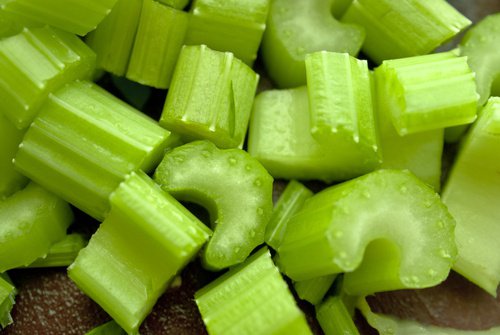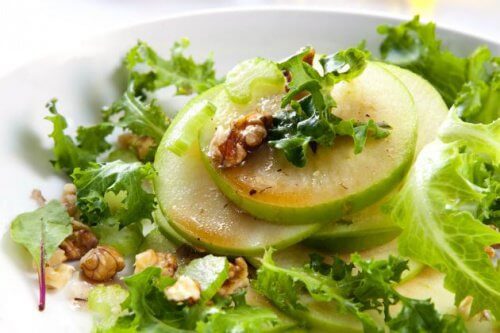Add Celery to Your Diet to Fight Inflammation


Written and verified by psychologist Valeria Sabater
Celery is a crisp, fresh tasting, refreshing vegetable that you can add to cooked dishes and salads. You might love the particular flavor celery adds to your food, but it’s also one of the healthiest vegetables out there, and can help fight inflammation, among other things.
The secret to celery’s health benefits is in the seeds, which contain aromatic substances. They’re rich in certain essential oils, which are what give it its inflammation-fighting properties, and also its ability to remove toxins from the body.
In today’s article, we’re going to show you why it’s worth making celery a regular part of your diet on a regular basis. Keep reading if you want to learn more!
Celery: a great way to lose weight and fight inflammation
Experts in vegetable studies say that when choosing celery, you should pick the brightest stalks, with thick, dense, firm stems.
Never choose celery that is soft, or with upper stems that have taken on a whitish color.
Celery can keep for three or four days when wrapped in a damp paper towel and stored in the refrigerator. When you’re ready to eat it, dip the bottom end of the stem in a little water to freshen it back up.
Once you’ve bought it and are ready to try it out, you’re probably wondering what kinds of benefits you’ll get from that “first bite” of celery.
You might like:
5 Revitalizing Celery Recipes
1. It’s a powerful anti-inflammatory agent
- One of the most interesting properties of celery is its ability to help you fight inflammation.
- This is due to the presence of polyacetyline, which not only helps your body eliminate toxins and promote healthy weight loss, it also provides relief for rheumatoid arthritis, osteoarthritis, gout, asthma, and bronchitis.
2. Celery, a food regulator
What on earth do we mean when we say that celery is a food regulator?
- Celery isn’t a primary source of energy because it doesn’t have any proteins or nutrients that bring you strength and vitality.
- Along with cucumber, celery is vegetable with a low energy content, but high purifying and hydrating powers
- It helps regulate internal processes by balancing mineral levels and cleansing the body thanks to its essential compounds.
- Celery is high in fiber, potassium, sodium, vitamins C and E, folate, calcium, and is made of mostly water.
3. Dietary properties of celery

- As you probably remember from the beginning of this article, one of the more interesting properties of celery lies in its essential oils, such as apiol, limonene, psoralens, or apilina.
- All of that contributes to the diuretic effects of this vegetable, which increases bile production and promotes better digestion.
- Another great aspect of celery is that it makes you feel satisfied. It’s highly recommended, therefore, that you drink a green smoothie every day to stay hydrated, cleanse your body, and prevent snacking between meals.
4. Benefits for your heart
- Celery is rich in a compound known as phthalide, which helps relax the muscles around the arteries and promotes proper circulation.
- And don’t forget that this vegetable is one of the best for balancing your cholesterol levels, while reducing levels of bad cholesterol, or LDL.
Read more:
Salad with celery and green apple to fight inflammation

It’s healthy, easy to make, and excellent as a side dish for salmon or chicken breast with lemon. It’s also easy to include in any diet.
Are you to ready write it down?
Ingredients
- 1 green apple
- 2 bunches of celery
- 5 large leaves of lettuce
- 100 g arugula
- 1 leaf of endive
- 5 walnuts, chopped
- The juice from half a lemon
- Mustard seeds (to taste)
- 4 teaspoons of honey (100 g)
- White pepper (to taste)
- A drizzle of extra virgin olive oil
Preparation
- Start by washing the celery and apple. Then chop both into small, bite-sized pieces. You don’t need to peel the apple first, but make sure you throw away the seeds.
- Chop the nuts.
- In a separate bowl, mix the lemon juice, mustard seeds, and honey. Then add the olive oil and white pepper. This will be your dressing.
- What’s the next step? It’s simple. Pick the bowl you’re going to serve this delicious salad in and add the lettuce and arugula. Then toss in the pieces of apple, celery, and nuts. Finally, add your dressing and enjoy every bite of this simple dish.
This is an ideal option for lunch, and is great for any weight loss plan. How could you resist it?
All cited sources were thoroughly reviewed by our team to ensure their quality, reliability, currency, and validity. The bibliography of this article was considered reliable and of academic or scientific accuracy.
- Malhotra, S. K. (2012). Celery. In Handbook of Herbs and Spices: Second Edition. https://doi.org/10.1533/9780857095688.249
- Chu, Y.-F., Sun, J., Wu, X., & Liu, R. H. (2002). Antioxidant and antiproliferative activities of common vegetables. Journal of Agricultural and Food Chemistry. https://doi.org/10.1021/jf020665f
- Miean, K. H., & Mohamed, S. (2001). Flavonoid (myricetin, quercetin, kaempferol, luteolin, and apigenin) content of edible tropical plants. Journal of Agricultural and Food Chemistry. https://doi.org/10.1021/jf000892m
- Papamichail, I., Louli, V., & Magoulas, K. (2000). Supercritical fluid extraction of celery seed oil. Journal of Supercritical Fluids. https://doi.org/10.1016/S0896-8446(00)00066-8
This text is provided for informational purposes only and does not replace consultation with a professional. If in doubt, consult your specialist.








